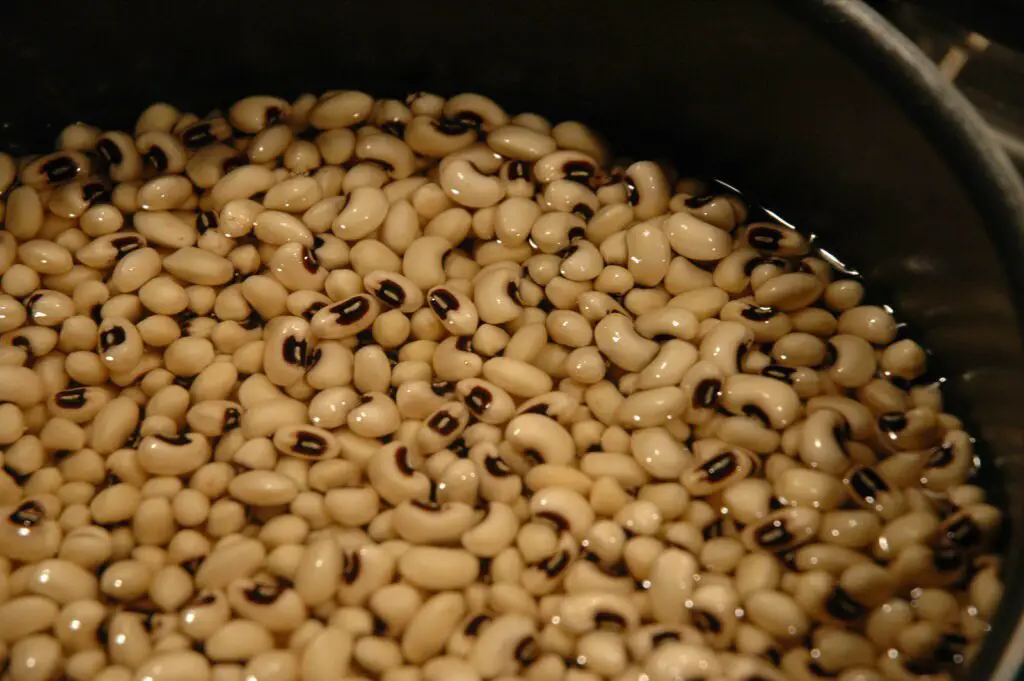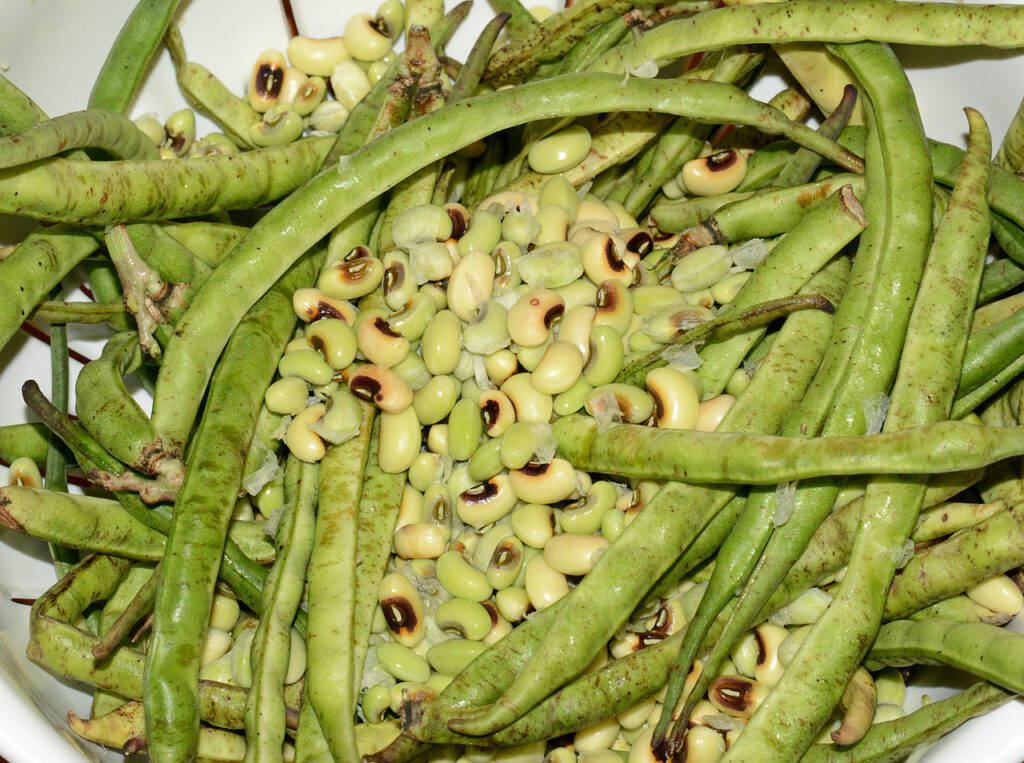As a proud pet parent, you may find yourself cooking up a storm in the kitchen, whipping up your favorite dishes while your furry friend looks on with hopeful eyes.
And when it comes to the humble black-eyed pea, you may wonder if it’s a delicious and nutritious treat worth sharing with your pup.
While some human foods can be harmful, others can bring added health benefits for your furry friend.
So, let’s take a closer look at whether or not dogs can safely enjoy this beloved legume as part of their diet.
- Can Dogs Eat Black-Eyed Peas?
- How Much Black-Eyed Peas Can Dogs Eat?
- How Often Can Dogs Eat Black-Eyed Peas
- Health Benefits of Black-Eyed Peas To Dogs
- Potential Risks of Feeding Black-Eyed Peas To Dogs
- Nutritional Benefits of Black-Eyed Peas For Dogs
- Are Dogs Sensitive To Black-Eyed Peas?
- How To Prepare Black-Eyed Peas For Dogs
- How Fast Will Dogs Digest Black-Eyed Peas
- In Conclusion
Can Dogs Eat Black-Eyed Peas?

Yes, dogs can eat cooked black-eyed peas but in moderation due to the high-calorie content.
Black-eyed peas are a good source of fiber, protein, vitamins, and minerals, including iron and zinc, but they tend to fall into the high-calorie food group.
However, it’s important to note that dogs have different nutritional requirements than humans, and their diets should primarily consist of high-quality dog food.
Additionally, some dogs may experience digestive issues such as gas or bloating if they eat too many black-eyed peas or other legumes.
As always, it’s best to consult with your veterinarian before introducing any new human foods to your dog’s diet.
See also: 47 Safe Vegetables To Feed Your Dog. Puppy Power!
How Much Black-Eyed Peas Can Dogs Eat?

While black-eyed peas are generally safe for dogs to eat, it’s important to feed them in moderation.
Like any new food, it’s best to introduce black-eyed peas slowly into your dog’s diet to see how they respond.
You should also take your dog’s size, age, and activity level into consideration. As a general rule of thumb, most vets recommend that treats should not make up more than 10% of a dog’s daily calories.
As a general guideline, half a cup of cooked black-eyed peas as a treat, occasionally, would be enough for a small-to-medium-sized dog. For larger dogs, you may be able to feed a slightly larger amount of up to one cup, but it’s still important to keep it within moderation.
So, you can give your dog small amounts of cooked black-eyed peas as a treat, but they should not replace your dog’s regular meals or consume a large portion of its daily calorie intake.
Black-Eyed Peas Feeding Chart According To Size
| Food | Size | Portion |
|---|---|---|
| Black-Eyed Peas | Toy dogs | half a cup |
| Black-Eyed Peas | Small dogs | half a cup |
| Black-Eyed Peas | Medium dogs | 1 cup |
| Black-Eyed Peas | Large Dogs | 1 cup |
Black-Eyed Peas Feeding Chart According To Age
| Food | Age | Portion |
|---|---|---|
| Black-Eyed Peas | 0 – 6 months | Don’t feed |
| Black-Eyed Peas | 6 – 12 months | half a cup |
| Black-Eyed Peas | 12 – 24 months | 1 cup |
| Black-Eyed Peas | 24+ months | 1 cup |
How Often Can Dogs Eat Black-Eyed Peas
Black-eyed peas can be safely consumed by dogs, but moderation is key.
Unless your vet recommends otherwise, you should always feed black-eyed peas as an occasional treat (a few times a week) or as part of a balanced meal.
Dogs have different nutritional needs than humans, and their diets should predominantly consist of high-quality dog food.
As a general rule of thumb, treats such as black-eyed peas should not make up more than 10% of your dog’s daily calorie intake.
Additionally, some dogs may have difficulty digesting legumes, so it’s essential to monitor them closely for any digestive issues after being fed black-eyed peas.
As always, whenever introducing new food to your dog’s diet, it’s best to consult with your veterinarian first.
Health Benefits of Black-Eyed Peas To Dogs
- Rich in Fiber. Black-eyed peas are a good source of dietary fiber, which can support digestive health in dogs by preventing constipation and diarrhea. Fiber also helps to keep dogs full and promote a healthy weight.
- High in Protein. Black-eyed peas are a plant-based protein that can support muscle health in dogs, as well as help to repair tissues and build stronger bones. Protein is essential to support the overall immune system and energy level in dogs.
- Source of Vitamins and Minerals. Black-eyed peas are rich in vitamins and minerals, including iron, magnesium, phosphorus, and zinc. These essential minerals and vitamins can support healthy skin and coats, strengthen bones, and promote energy.
- Low in Fat. Black-eyed peas are low in fat, making them an excellent option for overweight or obese dogs who need to maintain a healthy weight.
- Antioxidants. Black-eyed peas contain antioxidants that can support the immune system and protect against free radical damage.
- Complex Carbohydrates. Black-eyed peas are an excellent source of complex carbohydrates, which provide long-lasting energy to dogs while keeping their blood sugar levels stable.
Potential Risks of Feeding Black-Eyed Peas To Dogs
- Digestive Issues. Some dogs may experience digestive issues such as gas, bloating, or upset stomachs when consuming legumes like black-eyed peas. This is because these legumes contain complex sugars that are difficult for some dogs to digest.
- Allergic Reactions. Although rare, some dogs may be allergic to black-eyed peas. Symptoms of an allergic reaction can include skin irritation, itching, and respiratory problems.
- Interference with Medication. Black-eyed peas contain vitamin K, which can interfere with the effectiveness of blood-thinning medications. If your dog is taking any medication, it’s essential to consult with your veterinarian to determine whether black-eyed peas should be avoided.
- Obesity. While black-eyed peas are low in fat, they are still a source of calories. Overfeeding black-eyed peas can lead to weight gain and obesity in dogs.
- Dental Problems. Black-eyed peas can stick to a dog’s teeth, leading to the buildup of plaque and tartar, which can cause dental problems such as gum disease and tooth decay.
Nutritional Benefits of Black-Eyed Peas For Dogs
| Black-Eyed Peas Nutrition Facts per 100 grams | % DV * |
|---|---|
| Calories | 116 |
| Total Fat | 0.5 g |
| Cholesterol | 0 mg |
| Sugar | 3.3 g |
| Glycemic Index | 38 |
| Sodium | 4 mg |
| Carbs | 21 g |
| Protein | 8 g |
| Vitamin D | 0% |
| Calcium | 2% |
| Iron | 13% |
| Potassium | 278 mg |
Are Dogs Sensitive To Black-Eyed Peas?
Yes. While most dogs can safely consume black-eyed peas, some may experience sensitivity to this legume.
Sensitivity can result in various symptoms, such as:
- Vomiting: Dogs may experience vomiting after eating black-eyed peas if they are intolerant or sensitive to this ingredient.
- Diarrhea: Sensitive dogs may develop diarrhea after consuming black-eyed peas. This happens because of their body’s inability to break down the complex sugars in the legume.
- Abdominal Pain: Some dogs may experience discomfort and pain in their abdominal area after eating black-eyed peas.
- Loss of Appetite: If a dog is experiencing sensitivity to black-eyed peas, it may also lose its appetite and refuse to eat.
- Skin Irritation: Some dogs may develop skin irritation, itching, or hives.
If you notice any of these symptoms after feeding black-eyed peas to your dog, stop feeding them this ingredient immediately and contact your veterinarian for further advice. All dogs are unique and may react differently to black-eyed peas, so it’s essential to monitor your dog closely and speak with your veterinarian before adding any new food to their diet.
How To Prepare Black-Eyed Peas For Dogs
Plain-cooked black-eyed peas
The simplest way to prepare black-eyed peas for your dog is to cook them plain. You can boil the peas until they are tender, drain them, and cool them down before serving them to your pup.
Mixed in with dog food
Another way to incorporate black-eyed peas into your dog’s diet is to mix them in with their regular dog food. You can add a spoonful of cooked peas to their kibble, mix it in well, and serve.
Dog-friendly black-eyed pea dog treats
You can also find dog treat recipes that include black-eyed peas. Homemade dog treats can be a fun way to introduce more variety into your dog’s diet. A quick Google search will turn up many recipes that are safe for dogs, and with ingredients like peanut butter or cheese, they’re sure to be a hit with your furry friend.
How Fast Will Dogs Digest Black-Eyed Peas
Dogs typically digest black-eyed peas similarly to other types of legumes, which can take anywhere from a few hours to a full day to digest completely.
The speed of digestion can vary based on factors such as the individual dog’s digestive system, its size, and how thoroughly the black-eyed peas were cooked.
Although dogs can digest black-eyed peas, it’s essential to feed them in moderation, especially if introducing this legume into their diet for the first time, as overfeeding can lead to digestive issues such as gas, bloating, and upset stomachs.
As always, if you notice any severe symptoms or changes in your dog’s digestion or behavior after consuming black-eyed peas, contact your veterinarian.
In Conclusion
In conclusion, black-eyed peas can be a nutritious and healthy addition to your dog’s diet when fed in moderation.
They are a good source of fiber, protein, vitamins, and minerals, and can offer various health benefits, including supporting digestive health, promoting strong muscles and bones, and supporting the immune system.
However, it’s essential to monitor your dog’s reaction and to introduce black-eyed peas slowly to their diet.
Some dogs may experience sensitivity or allergic reactions to this ingredient, and it’s always best to consult with your veterinarian before making any changes to your dog’s diet.
Remember, black-eyed peas should always be fed as an occasional treat or as a supplement to a well-balanced diet consisting of high-quality dog food.


Leave a Reply